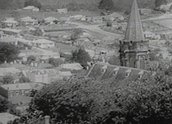

Bellbird (1970)
Synopsis
Located somewhere north of Melbourne in mixed grazing land, the town of Bellbird takes its name from the original homestead in the area, owned by the Chandler family, the last surviving member of which is Lori Chandler (Elspeth Ballantyne). Maggie Emerson (Gabrielle Hartley) is pregnant with her first child when a car crash precipitates a premature delivery. The baby dies and the shock affects the whole town in one way or another. Maggie’s husband, Colonel James Emerson (Carl Bleazby), blames himself because he was driving the car. The tragedy serves only to confirm his cynicism regarding the existence of ‘a merciful God’.
Curator’s notes
Longtime ABC writer-producer and Bellbird creator Barbara Vernon used to say the show was modelled on her own experience growing up in a small country town. That rural flavour was the defining element of this much-loved series, and the fact that the ABC reached far into regional Australia long before any other networks contributed to its loyal following.
Bellbird reflected serious issues like racism, parental abuse, alcoholism, pernicious gossip, xenophobia and generational conflict. A second generation Australian-Chinese character was among the original cast; a later story introduced an Indigenous Australian man married to a white woman. The acknowledgement that such characters even existed in contemporary life was unusual in our non-historical television drama of the 1960s and ’70s. In the episodes that appear on this site we have a bereaved father questioning the existence of God in bitter yet rational terms; not exactly conservative stuff, even today.
Scenes were rehearsed in the church hall across the road from the ABC’s Elsternwick studios for the first three days of the week, with tape mapping out the layout of the real sets on the floor and the marks individual actors were required to hit. On the fourth day the crew came in for a technical rehearsal with the actors and on the fifth, the four episodes – comprising one hour of content per week – were taped in studio, with all scenes in chronological order and each episode shot in one continuous 15-minute sequence.
Bellbird is a visual record of the fashions of the time, in accents and music as much as clothes (see clip one). There are miniskirts everywhere but older women still wore hats and gloves to go shopping. Perhaps even stranger for viewers today, is the ‘educated Australian’ accents of the majority of the cast. They sound false now that we are so used to the natural sound of the Australian accent, but it was not only the norm among performers then, it was also what the viewing public expected of ‘nice’ characters. On telly, only villains and comic characters spoke with broad Australian accents, whatever the reality in life.
This would change in a few years. The films Stork (1971) and The Adventures of Barry McKenzie (1972) were just around the corner, and Network Ten’s raunchy new serial, Number 96 (1972–77), was about to hit television audiences. In the ensuing years the ABC tried changing formats and time-slots on Bellbird to boost fading ratings but eventually gave up in December 1977. By then there were at least nine homemade serials on air with more in the pipeline. Bellbird provided broad shoulders for the serials that followed, most notably the similarly rural-set A Country Practice (1981–93).
Bellbird first went to air nationally on the ABC on 26 August 1967 and ran for 10 years to December 1977. For most of that time it was formatted in weekly blocks of 4 × 15 minute episodes, programmed as a lead-in to the 7 pm news. The four episodes concerning Maggie’s baby are 'Block 97’ and were broadcast in 1970.
These are some of the earliest surviving recordings of Bellbird as previous episodes from the 1960s were erased in order to re-use the videotapes – a common practice at the time. Bellbird is remembered in the film Country Town (1971), devised by two of the actors who appear in clip one, Gary Gray and Terry McDermott. A novel written by the serial’s creator, Barbara Vernon, was published in 1970.
- Overview
- Curator’s notes
- Video 2 clips
- Principal credits
- Find a copy
- Make a comment
- Add your review



